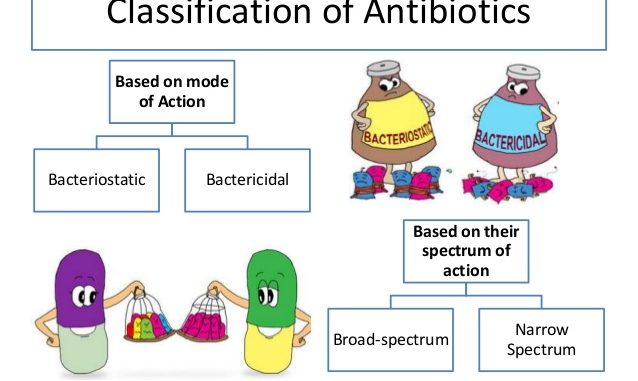
Classification of antibiotics
Antibiotics: Antibiotics are the chemical therapeutic agents of microbial or synthetic or semi-synthetic origin which in lower concentration inhibit the growth of other microorganisms.
Classification of antibiotics
A] On the basis of chemical structure
B] On the basis of origin
C] On the basis of range of activity ( spectrum of activity)
D] On the basis of mode of action
E] On the basis of effects of their activity
F] On the basis of route of administration
A] Classification of antibiotics on the basis of chemical structure:
- Carbohydrate containing Antibiotics:
- Pure saccharides antibiotics: examples; Streptozotocin
- Aminoglycosides: examples; Streptomycin
- N/O glycosides: eg. Chromomycin
- Other: eg; Lincomycin
- Macrocyclic lactone antibiotics: eg. Erythromycin
- Quinolones antibiotics; eg. Fluroquinolone
- N-containing heterocyclic antibiotics: eg. Beta-lactum
- O-containing heterocyclic antibiotics: eg. Cycloserine
- Alicyclic antibiotics: eg. Cycloheximide
- Aromatic antibiotics (Nitrobenzene): eg. Chloramphenicol
- Aliphatic amine antibiotics: eg. Spermidine
- Peptide antibiotics: eg. Polymyxin, Bacitracin, Gramicidin
B] Classification of antibiotics on the basis of origin:
1.Microbial origin:
i. Bacterial origin:
Bacillus polymyxa: Polymyxin
Chromobacter violaceum: Bacitracin
Micromonospora spp: Gentamycin
ii. Fungal origin:
Penicillium notatum: Penicillin
Cephalosporin spp: Cephalosporin
iii. Actimomycetes origin:
Streptomyces griseus: Streptomycin
S. venezuelue: Chloramphenicol
S. erythreus: Erythromycin
S. mediterranae: Rifampicin
S. venezuelae: Chloramphenicol
2. Semi-synthetic antibiotics:
- Examples: Amoxycillin, Ampicillin, Doxycycline, Tigecycline, Sulfonamide etc
3. Synthetic antibiotics:
- Examples: Chloramphenicol (* it was extracted from Streptomyces venzuelae but now produced synthetically), 4-quinolones, Sulfonamide
C] Classification of antibiotics on the basis of range of activity (spectrum of activity):
1.Narrow spectrum:
- Active towards relatively fewer microorganisms.
- Examples: macrolides, Polymyxin
2. Moderate spectrum:
- Active towards Gram Positive bacteria as well as some systemic and UTI causing Gram negative bacteria.
- Examples: Aminoglycosides, Sulfonamide
3. Narrow-Broad spectrum:
- Active against Gram positive and gram negative
- Examples: Beta-lactum
4. Broad spectrum:
- Active against Gram positive and Gram negative except Pseudomonas and Mycobacteria.
- Examples: Chloramphenicol, Tetracycline
5. Anti-mycobacterial antibiotics:
- Examples: Ethambutol, Rifampicin, Isoniazid, Pyrazinamide
D] Classification of antibiotics on the basis of Mode of action:
1. Inhibitor of cell wall synthesis/ Peptidoglycan Inhibitors:
Examples:
- Beta-lactum; Penicillin
- Bacitracin
- Cycloserine
- Phosphomycin
- Cephalosporin
- Vancomycin
2. Inhibitor of protein synthesis:
Examples:
- Streptomycin
- Aminoglycosides
- Fusidic acid
- Tetracycline
- Mupirocin
- Chloramphenicol
- Macrolides
3. Inhibitor of Nucleic acid synthesis:
Examples:
- Quinolones
- Ciprofloxacin
- Nalidixic acid
- Metronidazole
- Nitrofurantoin
4. Inhibitor of folic acid synthesis (Folate antagonistic)
Examples:
- Sulfonamide
- Trimethoprim
5. Inhibitor of cytoplasmic membrane:
Examples:
- Polymyxin; Colistin
E] Classification of antibiotics on the basis of effects of their activity:
1. Bactericidal:
- Kills bacteria
- Examples: Aminoglycosides, Penicillin, Cephalosporin
2. Bacteriostatic:
- Inhibits the growth of bacteria
- Examples: Sulfonamide, tetracycline, chloramphenicol, trimethoprim, macrolides, Lincosamide
F] Classification of antibiotics on the basis of Route of administration:
1. Oral antibiotics:
- Acid stable antibiotics,
- Examples; Penicillin V
2. Parenteral route:
- Intravenous administration
- Examples; Penicillin G
